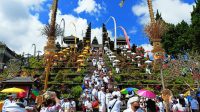NGABEN or cremation ceremony in Hindu is a ritual procession of releasing the human five elements to its origin in nature, releasing the bond of the deceased soul from its physical body and letting go the death of the deceased. Hopefully, the soul can peacefully depart to the afterlife realm in accordance with its karma or deeds.
In series of the cremation ceremony, the ritual is accompanied with ngoncang tradition. It is held before the corpse or its symbolic item is carried to cemetery for further procession.
History
In the past, agrarian people processed the harvest from husked rice into rice manually, namely by pounding it in a wooden mortar or ketungan before the presence of a milling machine. This process then gave birth to a tradition called Ngoncang.
As it sounds, this tradition is quite interesting and unique. Indeed, this tradition is rarely found today, but there are still those who still maintain this ancestral heritage faithfully so that it remains sustainable until now.
The Ngoncang tradition is thought to have existed since the entry of Hindu influences from India to Bali in the fourth century. This tradition is believed to bring in a balance of sekala (physical) and niskala (psychical) life.
Function
The tradition of pounding rice in ketungan produces a unique sound. In harmony with the progress of the times, gradually the development of mechanization tools such as rice milling finally shifted the ketungan so that it is abandoned. As consequence, the Ngoncang tradition is threatened with extinction.
Now where can this tradition be found? Some areas in Bali still carry out this tradition in relation to certain rituals, such as welcoming Nyepi celebrations, children’s otonan (birthday) or when natural disaster such as lunar eclipses and earthquake occur.
Besides, the Ngaben or cremation ceremony of Hindus is also accompanied with this ngoncang tradition. The dynamic sound of ketungan is considered to be able to communicate with the souls and melt all their impurities.
The community does this in groups by beating a pestle on a mortar or ketungan to produce a dynamic sound. If there is no pestle, it can be replaced with a short wooden stick. By and large, it is done by housewives. However, if unavailable they can be replaced by men instead.
Etymologically, the word ngoncang means ‘boisterous sound’ (boisterous = clear). The philosophy is that all forms of ceremonies must be communicated clearly so as to create a harmonious relationship, both with the environment, fellow humans and the Creator.
Preservation
As a measure to preserve this ancestral cultural heritage, the government sometime holds a competition, so that it becomes an entertainment and can even become a unique tourist attraction.










